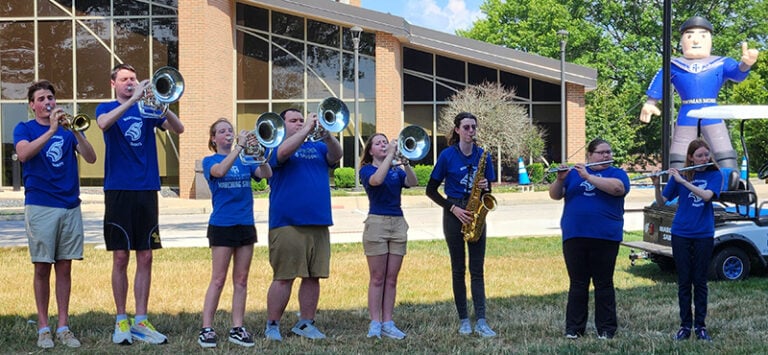The old saying “what goes up must come down” is certainly applicable to Kentucky’s white-tailed deer season harvest.
During the past 10 seasons the deer harvest has been trending in a range between a high of 155,720 in 2015, to a low of 132,327 in 2021.

At this stage in the management of deer herds in our 120 counties, fluctuations in the deer harvest from year-to-year are a normal occurrence, affected by factors such as the level of hunter participation, deer reproductive success the previous year, weather conditions during the season, and the size of the mast (nut) crop, which is a factor in how much deer move around in their home range.
The 136-day 2023 season ended Monday, January 15.
Here are highlights based on the harvest statistics posted on January 16 on the Kentucky Department of Fish and Wildlife Resources (KDFWR) website:
• There were 140,812 deer reported taken, which is 3,703 fewer than last year, and represents a 2.56 percent decline. During the 2022 season hunters reported taking 144,515 deer.
• The total harvest was 56.53 percent male deer and 43.47 percent female. Of the bucks harvested, 72,522 had visible antlers.
• Harvest by weapon type for the 2023 season was: archery, 14,959; modern firearm, 103,315; muzzleloader, 10,175, and crossbow, 12,363.
Top regions and counties

The state is divided into five wildlife regions.
The top region was the Green River wildlife region, where 41,126 deer were reported taken in 26 counties.
In the Bluegrass wildlife region, which includes 32 counties from Boone County southward, the deer harvest was 37,969.
The top county in the region was Shelby County, with 2,683 deer reported taken. The top counties in northern Kentucky were: Pendleton, 2,452 and Grant, 1,630.
Deer harvest in the other three wildlife regions was:
• Northeast region, 17,758.
• Southeast region, 23,249.
• Purchase region, 20,710.
Statewide, the top 10 counties in deer harvest were:
1. Hardin (Zone 1), 3,443.
2. Christian (Zone 1 ), 3,070.
3. Breckinridge (Zone 2), 3,017.
4. Shelby (Zone 1), 2,683.
5. Crittenden (Zone 1), 2,659.
6. Hopkins (Zone 1), 2,487.
7. Ohio (Zone 2), 2,473.
8. Graves (Zone 1), 2,469.
9. Nelson (Zone 1), 2,458.
10. Pendleton (Zone 1), 2,452.
10. Grayson (Zone 2), 2,452.

Overall there were 44 counties with a deer harvest of more than 1,000, 18 counties with a harvest of more than 2,000 and three counties with a harvest of more than 3,000.
Menifee County, for the second year in a row, had the lowest harvest in the state, 181 deer.
Zone 1 counties have the highest deer densities in the state, above management goals. In the Zone 1 counties there’s an unlimited bag limit on antlerless deer, provided hunters have obtained the required permits. For the 2023 season there were 51 Zone 1 counties.
Chronic Wasting Disease reported
For the first time a deer taken by a hunter in Kentucky has tested positive for Chronic Wasting Disease (CWD).
The 2 1/2-year old buck was harvested on opening day of modern gun season, November 11, in Ballard County.
On December 7, department officials said two tests confirmed that the deer tested positive. KDFWR Commissioner Rich Storm said in a statement “(We) hoped this day would never come… although CWD is always fatal to infected individual animals, by following best practices we can minimize its impact on the long-term health and sustainability of our deer herd.”

The department’s CWD response plan Is available online at fw.ky.gov/CWDResponsePlan.
CWD is a fatal, untreatable, neurological disease of the brain and nervous system that affects deer, elk and other species in the deer family. This highly contagious disease, caused by a protein called a prion, was first recognized as a “wasting syndrome” in mule deer at a research facility in Colorado in 1967 and has since spread to free-ranging and captive populations in 30 U.S. states and four Canadian Provinces.
Currently, no evidence suggests that CWD can infect humans, according to The Centers for Disease Control and Prevention, the U.S. national public health agency.
But as a caution, hunters are urged to be vigilant when handling, processing, and consuming meat from harvested game. Hunters should not harvest or handle any animals that appear sick or unhealthy, and report any sick or unhealthy deer they observe to KDFWR.
KDFWR established a CWD surveillance zone in 2021 in Calloway, Fulton, Graves, Hickman and Marshall counties to test hunter-harvested deer after deer in Tennessee, near the Kentucky border, tested positive for CWD. Special regulations in the zone were also enacted.
With a CWD positive deer confirmed in Ballard County it’s likely the surveillance zone will be expanded for the 2024 deer season.


















